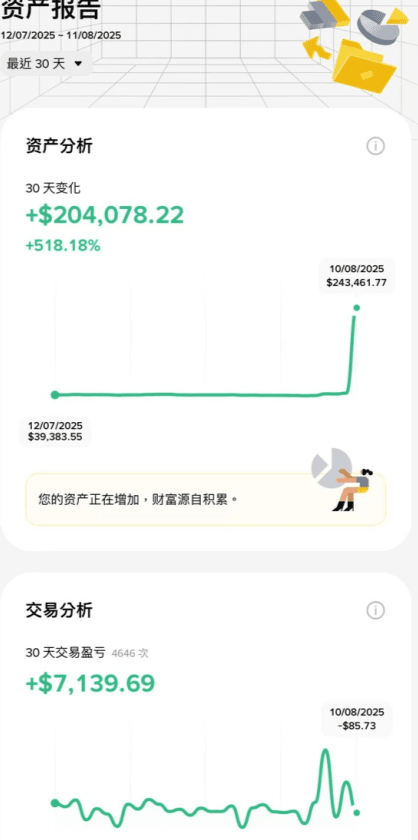Making money in the crypto market may not be difficult, but when transferring funds back to traditional accounts, many newcomers often encounter frustrating issues: seemingly ordinary OTC transactions from months ago suddenly being notified of fraud, leaving them confused and panicked. Today, let's break this down clearly.
1. Why was there 'no problem at the time, but later there was'? The timeline clarifies it for you.
Many people wonder: why was there no warning from the bank or platform at the time of the transaction, and then suddenly there is a 'blow-up' months later? The core reason is the lag in fund tracing.
Fraud or gray market activities may use the victim's money to pay you, making you think they are just an ordinary buyer; they may also use a 'scoring intermediary's card' or 'someone else's account', or the payment account may not match the actual entity. At this point, when you receive the funds and release the coins, everything seems normal—after all, banks and platforms cannot determine in real-time whether the funds are 'dirty money'.
But weeks or even months later, when the victim reports to the police, they will trace the funds backwards, and the bank will submit suspicious transaction reports. Following the money trail, your account has become one of the nodes, and the bank or police will contact you to explain the situation, even temporarily controlling your account.
Note: This does not mean 'determining you are a criminal'; it is merely the retrospective nature of the funding chain verification at work.
2. What operations are likely to get you 'named'? Be cautious of these points.
Not all OTC transactions will be monitored; the following behaviors are more likely to trigger risks:
Frequent receipt of funds from strangers, frequently changing bank cards, and logging in from multiple locations;
Transaction notes containing sensitive words such as 'coin', 'USDT', 'digital currency', or frequently receiving large amounts of money late at night;
The account acts like a 'transit station', with funds being transferred immediately upon arrival, and a mix of corporate and personal receipts;
The name of the payer does not match the real-name registered entity on the platform, or is even inconsistent with the information of the chat partner.
These details may seem insignificant, but they could make you a focus of verification.
3. Don’t panic if you receive a fraud notification! This is the most reliable way to protect yourself.
When encountering such matters, first stabilize, and remember a few key principles:
Verify identity: Police or banks will not ask for transfers, verification codes, or online banking passwords, and will provide official document numbers or unit names. If the other party suggests 'private chat' or 'remote screen sharing', it is likely a scam, and you should hang up and call the official number to verify.
Standard refund: Even if you need to return the funds involved in the case, it must go through the accounts and processes designated by the police or court, and always ask for formal receipts, case closure, or case withdrawal proof afterward. Refuse 'informal mediation transfers' to avoid falling into a second pit.
Cooperate with the investigation: If your account is temporarily controlled, do not resist, keep transaction records, chat records, and other evidence well, and actively cooperate to speed up problem resolution.
4. What will happen next? Explanation of several common outcomes.
After being notified of involvement in fraud, the outcome varies based on the verification situation:
Complete materials and clear transaction records: verification may directly resolve doubts;
Temporary account control: may restrict receiving and making payments, ATM withdrawals will be restored after the investigation is concluded;
Funds involved in the case: the amount in question may be stopped or frozen, and you will need to wait for the case's progress;
Listed for risk control observation: subsequent transactions may be subject to spot checks, requiring more standardized operations.
Processes and times vary by region, but the more complete the materials and the more professional the communication, the higher the processing efficiency.
5. Want to avoid pitfalls? Do these points to reduce the probability of being traced.
Rather than panicking afterward, it is better to prevent in advance; these points can help you reduce risk:
Before the transaction: only use mainstream platform official P2P or escrow functions, check the buyer's order volume, positive feedback rate, and real-name verification; refuse third-party payments or company payments, only accept payments from accounts that match the buyer's platform real-name registration.
During the transaction: confirm that the payer's name matches the buyer's real-name registration; if not, do not release the coins; save chat records and payment proof, large transactions can create comparison tables.
Account management: specifically open accounts for OTC receipts, do not mix with personal or company accounts; log in with fixed devices and networks to avoid operations from multiple locations and IPs; do not assist others in collecting or transferring funds to prevent becoming a 'transit account'.
Detail control: break large transactions into smaller ones, and complete them during the day in segments; agree with the other party in advance to use neutral terms like 'order number' in the notes to avoid sensitive words.
Ultimately, standardized operations are the most solid guarantee. When problems arise, calmly cooperate with the verification to ensure the fund transfer is more secure.
I am A Yu, your analyst friend, and I do one thing: use practical experience to help you make money.
Are you stuck, confused, or unsure how to operate? Don’t panic. Follow A Yu, don’t guess the ups and downs, only provide plans that can help you profit.
Pay attention today: ETH JUV SKL
#美国7月PPI年率高于预期 #ETH突破4600 #主流币轮动上涨




